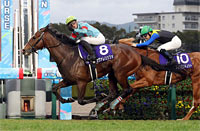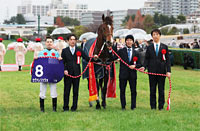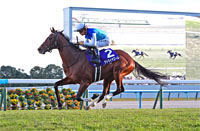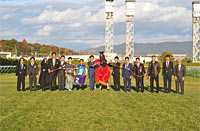Asahi Hai Futurity Stakes (G1) - Data Analysis
Two-year-olds battle for supremacy in mile race that serves an indicator of future performance
Looking back at the Asahi Hai Futurity Stakes since 2014, when the race was moved to Hanshin Racecourse, we observe that 2018 winner Admire Mars went on to secure victories in the NHK Mile Cup and the Hong Kong Mile as a three-year-old, thereby notching wins in both overseas and domestic G1 races. Among the 2021 runners, winner Do Deuce dominated the Tokyo Yushun (Japanese Derby) the next spring, while runner-up Serifos, third-place finisher Danon Scorpion, and fifth-place finisher Geoglyph also triumphed in a G1 race the following year. In other words, a large number of runners that have contested the Asahi Hai Futurity Stakes have enjoyed success in their later career. What trends can we expect in this race that—as its name (“futurity”) suggests—is contested by a field of promising two-year-olds? Let’s now look for some trends based on data for the last nine years during which the race was held at Hanshin Racecourse.
Top 3 often comprises two favored runners and one dark horse
While runners backed as 3rd favorite or higher were all beaten to 4th or lower in an upset in 2016, race favorites have finished in the Top 3 in eight of the last nine years (excluding 2016). During the same eight years, at least one of the runners backed as 2nd favorite or 3rd favorite also finished in the Top 3, so favored runners appear to be highly reliable contenders. However, in five of the eight years, one of the Top 3 finishers was backed as 7th favorite or lower, which means we also need to consider runners backed by poor favoritism in our selection. [Table 1]
[Table 1] Performance by favoritism (last nine years)
| Favoritism |
Performance
[1st-2nd-3rd-4th or lower] |
Win ratio |
Top 2 ratio |
Top 3 ratio |
| 1st favorite |
4-2-2-1 |
44.4% |
66.7% |
88.9% |
| 2nd favorite |
2-3-1-3 |
22.2% |
55.6% |
66.7% |
| 3rd favorite |
1-1-2-5 |
11.1% |
22.2% |
44.4% |
| 4th favorite |
0-0-1-8 |
0% |
0% |
11.1% |
| 5th favorite |
0-0-0-9 |
0% |
0% |
0% |
| 6th-9th favorite |
2-2-0-32 |
5.6% |
11.1% |
11.1% |
| 10th favorite or lower |
0-1-3-62 |
0% |
1.5% |
6.1% |
Focus on runners coming from mile-long graded races
Looking at performances by runners over the last nine years in terms of their previous race, we find that among Top 3 finishers, seven had contested the Daily Hai Nisai Stakes in their previous race and six the Saudi Arabia Royal Cup. We should therefore keep in mind that many runners coming from a 1,600m graded turf race have fared well. [Table 2]
[Table 2] Performance by previous race (last nine years)
| Previous race |
Performance
[1st-2nd-3rd-4th or lower] |
Win ratio |
Top 2 ratio |
Top 3 ratio |
| Saudi Arabia Royal Cup |
3-2-1-5 |
27.3% |
45.5% |
54.5% |
| Daily Hai Nisai Stakes |
1-4-2-17 |
4.2% |
20.8% |
29.2% |
| Keio Hai Nisai Stakes |
0-2-2-21 |
0% |
8.0% |
16.0% |
| Other JRA graded race |
0-1-1-14 |
0% |
6.3% |
12.5% |
| Open-class race |
1-0-1-18 |
5.0% |
5.0% |
10.0% |
| 1-win class race |
2-0-0-27 |
6.9% |
6.9% |
6.9% |
| Newcomer race |
1-0-1-3 |
20.0% |
20.0% |
40.0% |
| Maiden class |
1-0-1-12 |
7.1% |
7.1% |
14.3% |
| NAR race |
0-0-0-3 |
0% |
0% |
0% |
Note: Listed races are included under open-class races.
In addition, 2014 winner Danon Platina and 2016 winner Satono Ares, who both came straight from a 1-win class race, had contested the Begonia Sho as their previous race within the two preceding weeks, achieving success after a short race interval. Since 2017, however, runners entering the race within three weeks or less since their previous race have not produced any winners and achieved a Top 3 ratio of only 7.1%. [Table 3]
[Table 3] Performance by interval since previous race (last six years)
Interval since
previous race |
Performance
[1st-2nd-3rd-4th or lower] |
Win ratio |
Top 2 ratio |
Top 3 ratio |
| Three weeks or less |
0-1-1-26 |
0% |
3.6% |
7.1% |
| Four weeks or more |
6-5-5-51 |
9.0% |
16.4% |
23.9% |
Need to discount runners that have been beaten in their previous race
The last nine winners all came to this race after notching the win in their previous race. As shown in Table 2, runners coming from a victory in the Saudi Arabia Royal Cup or Daily Hai Nisai Stakes delivered outstanding performance of [4-3-2-3], achieving a high Top 3 ratio of 75.0%. Conversely, runners that had finished 2nd or lower in either of these races delivered lackluster performance of [0-3-1-19] (Top 3 ratio of 17.4%). We should therefore lower our expectations of runners that have been defeated in their previous race. [Table 4]
[Table 4] Performance by finish in previous race (last nine years)
| Finish in previous race |
Performance
[1st-2nd-3rd-4th or lower] |
Win ratio |
Top 2 ratio |
Top 3 ratio |
| 1st |
9-5-7-58 |
11.4% |
17.7% |
26.6% |
| 2nd or lower |
0-4-2-62 |
0% |
5.9% |
8.8% |
Runners with 4 career starts look appealing
Looking at performances by runners over the last nine years in terms of career starts, we note that success ratios drop as the number of career starts increases. Among runners with 4 careers starts, even those backed as 6th favorite or lower did not show much of a drop in success rates with performance of [1-1-2-22] and a Top 3 ratio of 15.4%, which are interesting statistics. In addition, 2014 runner-up Arma Waioli, 2015 third-place finisher Shadow Approach, and 2016 third-place finisher Bom Servico performed well despite being backed as 10th favorite or higher, further adding to the appeal of runners with 4 career starts. [Table 5]
[Table 5] Performance by total career starts (last nine years)
| Total career starts |
Performance
[1st-2nd-3rd-4th or lower] |
Win ratio |
Top 2 ratio |
Top 3 ratio |
| 1 |
1-0-1-3 |
20.0% |
20.0% |
40.0% |
| 2 |
4-4-3-32 |
9.3% |
18.6% |
25.6% |
| 3 |
3-4-1-34 |
7.1% |
16.7% |
19.0% |
| 4 |
1-1-4-28 |
2.9% |
5.9% |
17.6% |
| 5 or more |
0-0-0-23 |
0% |
0% |
0% |
Seek out the winner!
Career warrants close attention
As shown above, runners that had been beaten in their previous race and runners with 5 or more career starts have produced zero winners. Shared features among the last nine winners were that they had no experience of contesting a race with a distance below 1,400m, and that they had never been beaten to 5th or lower. If we also consider that all nine winners had been backed as 2nd favorite or higher in their previous race, we should be able to narrow down likely win contenders. [Table 6]
[Table 6] Winners’ shortest-distance race contested to date, lowest finish to date, and favoritism in previous race (last nine years)
| Year |
Winner |
Shortest distance |
Lowest finish |
Favoritism in
previous race |
| 2014 |
Danon Platina |
1,500m |
2nd |
1st favorite |
| 2015 |
Leontes |
2,000m |
1st |
1st favorite |
| 2016 |
Satono Ares |
1,600m |
2nd |
2nd favorite |
| 2017 |
Danon Premium |
1,600m |
1st |
2nd favorite |
| 2018 |
Admire Mars |
1,600m |
1st |
1st favorite |
| 2019 |
Salios |
1,600m |
1st |
1st favorite |
| 2020 |
Grenadier Guards |
1,400m |
4th |
1st favorite |
| 2021 |
Do Deuce |
1,800m |
1st |
2nd favorite |
| 2022 |
Dolce More |
1,500m |
1st |
2nd favorite |
(Maya Takanami)
|

- Preview
- Barrier draw
- Past performances of runners

- News
- Race result
- Video
- 2025 English

- 2024 English

- 2023 English

- 2022 English

- 2021 English

- 2020 English

- 2019 English

- 2018 English

- 2017 English

- 2016 English

- 2015 English

- 2014 English

- 2013 English

- 2012 English

- Photo Gallery
2025 Winner: Cavallerizzo


2024 Winner: Admire Zoom


|


















